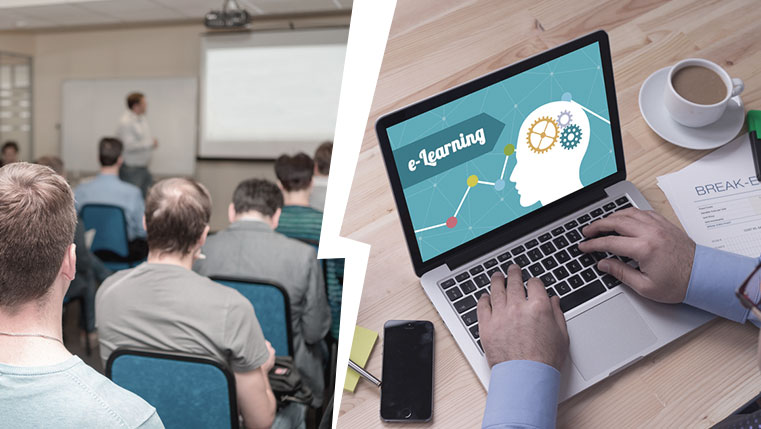When to Use Both ILT and eLearning?

Many organizations across the globe prefer to impart training to their employees in an instructor-led environment. They find conventional classroom methods more effective when it comes to helping learners gain the knowledge and skills needed for doing their jobs better. The learning process becomes engaging in the presence of an instructor, and helps learners stay actively involved.
On the other hand, many organizations favor eLearning for the simple fact that online courses are self-paced and offer simultaneous reach to all learners. It is an important factor for organizations with a global presence and diverse workforce.
However, conventional classroom training methods are highly inflexible and hinder smooth training. Similarly, eLearning methods can be ineffective if not applied correctly. Wondering which method will be best for your training requirements? Wondering if you can use both?
To overcome the limitations of conventional classroom training, it’s time to adopt a mix of both the methods where learners can attend trainer-led sessions and also have the option of self-paced eLearning modules that can be accessed outside the class.
In this way, eLearning solutions can reduce some part of the time spent on trainer-led sessions. In a mix-mode method like this, technology-enabled learning solutions will complement trainer-led classroom sessions, to provide a rich learning experience. Read this post to know when you should consider both ILT and eLearning for imparting training.
Type of Training Requirement
The nature of the training requirements or the learning objectives is one of the key factors that have to be evaluated before you decide on a delivery format for the course. For instance, if your organization needs to train employees on software, it can be either done through classroom with the help of presentations and practice on the software or with self-paced eLearning modules.
Both methods can be effective, considering the type of content and the target audience’s preference. When you need to assess your learners on conceptual knowledge, an online assessment is all you need. But, if you have to test the level of skill acquirement, creating hands-on assessments with the real-life scenarios is the best way.
Types of Learners
Employees in your organization will have their preferred way of learning. Some might learn better with ILTs and some might find eLearning convenient. It’s necessary to evaluate whether providing additional resources will benefit learners. It is also important to look at the level of experience of your employees.
For instance, if the training is about a service or a product, senior employees will have enough knowledge about it and need not go through the entire training. They can be provided with eLearning modules which consist of an overview as a refresher and the latest features to keep them updated about the product. But, if it’s a new product, some part of the training can be done online and hands-on exercises can be held later.
Employees Across the Globe
Training a diverse workforce across the globe is a cumbersome task when it comes to classroom training methods. Employees and instructors have to fly in from different locations, adding to your expenses. With the use of a wide array of virtual tools in eLearning, you ensure that employees receive a consistent message throughout.
With blended learning, you can reach as many employees as you need to. Webinars and support resources that can be accessed on mobile devices are available whenever and wherever the employee needs it. You can assess employees on the field once the eLearning training is over.
Short Time for Complex Topics
Training in some areas will take learners more time to learn and gain expertise in it. For instance, employees need to be trained on machine handling. If the training is led by an instructor, it will take long to understand its functions, precautions, features etc. But, if you use eLearning with ILT, there can be considerable time saving.
ELearning can be used effectively if you have to show the features of a machine and how it works. Animations, scenarios, simulations, etc., can be included in the eLearning course to make it more interesting than just going through theory. Once it’s done, employees can practice with hands-on sessions with the instructor.
Frequent Trainings
In industries such as Retail, due to the high turnover rate, training is a cumbersome task. But organizations must train new employees frequently. With a blended learning approach, most of the training can be moved online, to reduce the time required for the instructor to train the employees. You can use eLearning solutions to impart training as many times to as many employees you want.
Just-In-Time Content
With eLearning, provide just-in time content to your employees after your classroom training gets over. For instance, technicians can go through videos or graphics on their mobile devices when they need to fix any device, instead of going through long manuals which can be divided into type, model, and brands and so on. These videos and graphics will work as a refresher guide, enabling them to work on the task quickly and efficiently.
If implemented appropriately, the blend of ILT and eLearning can far outweigh the benefits of using just one method.





